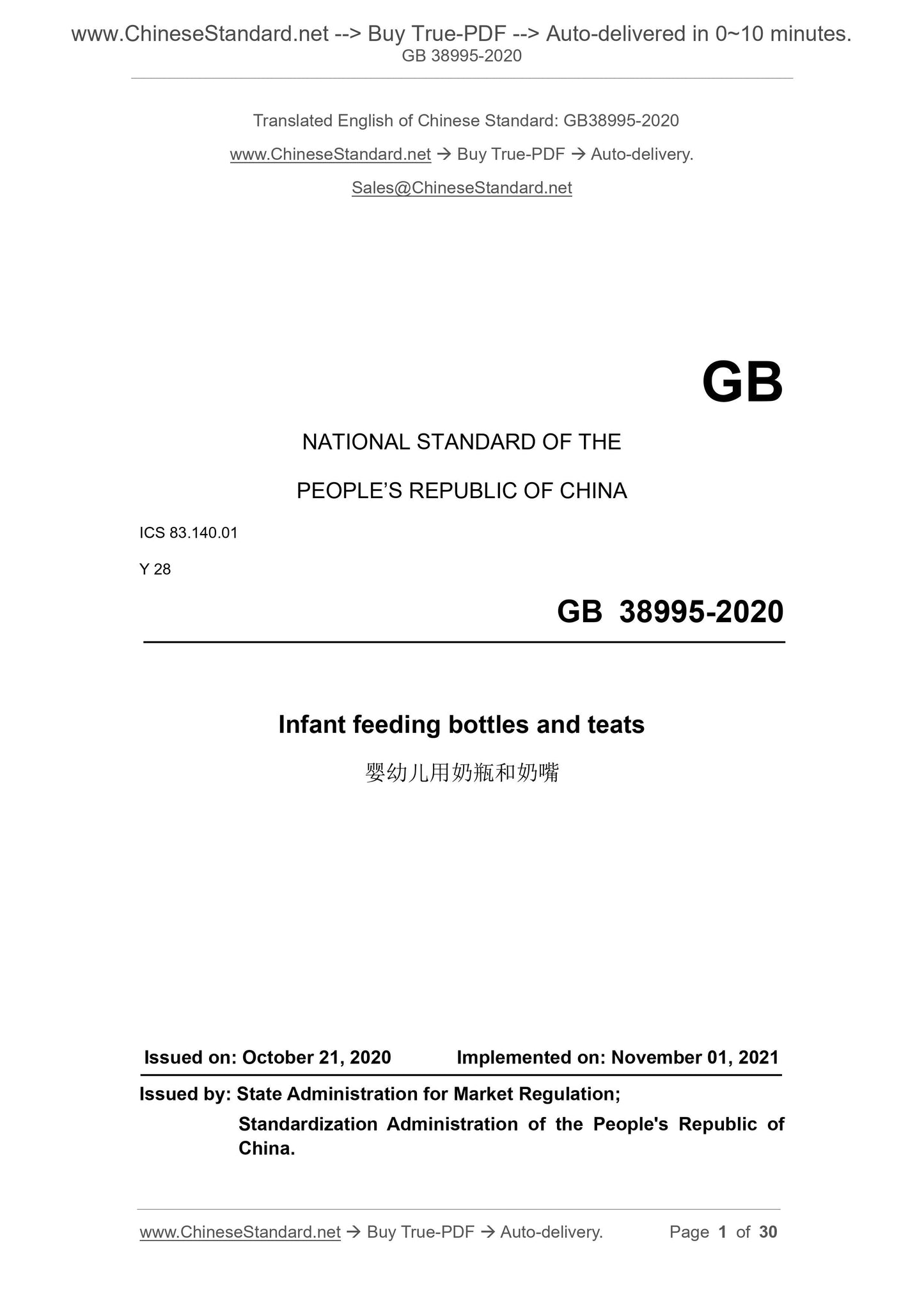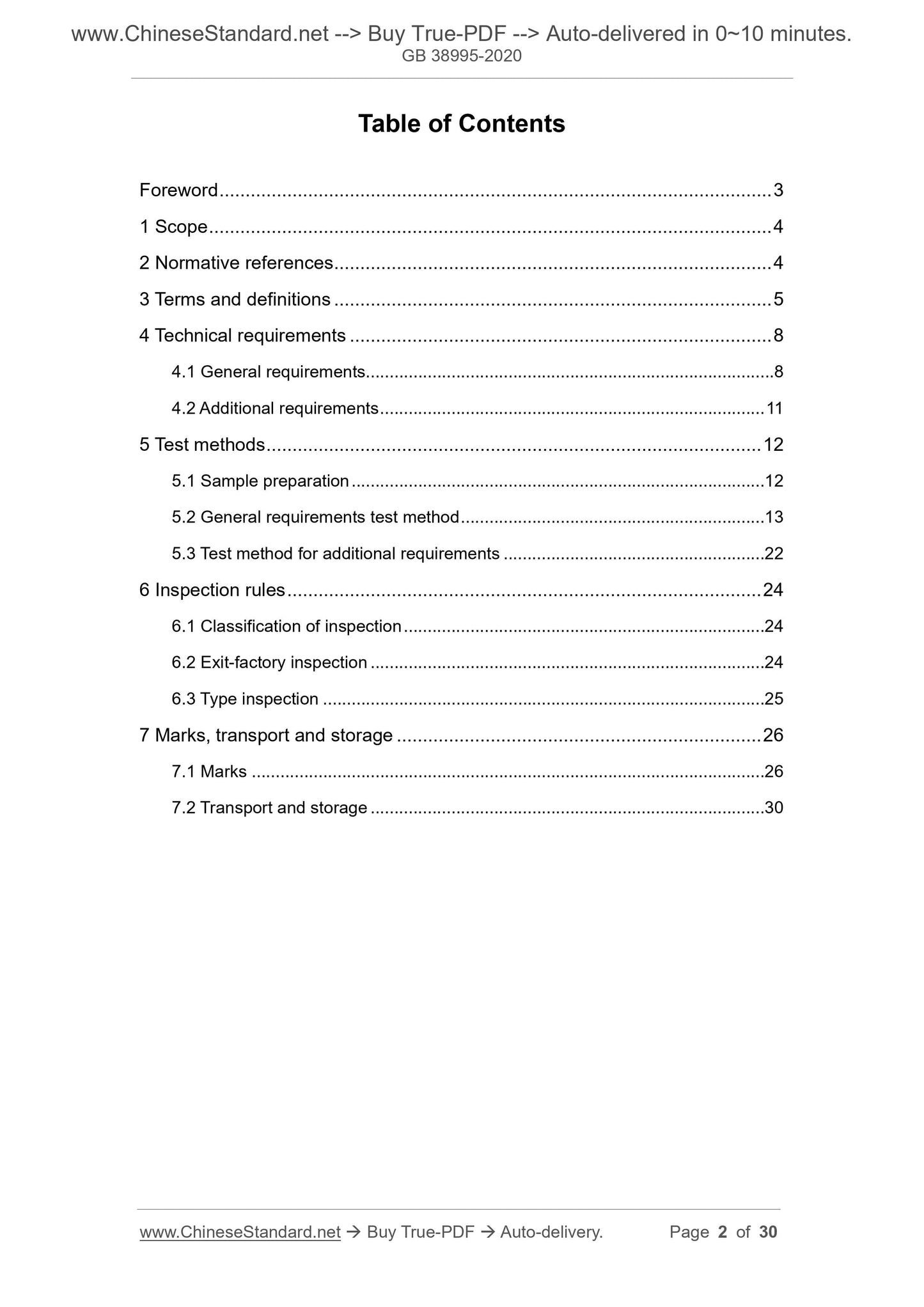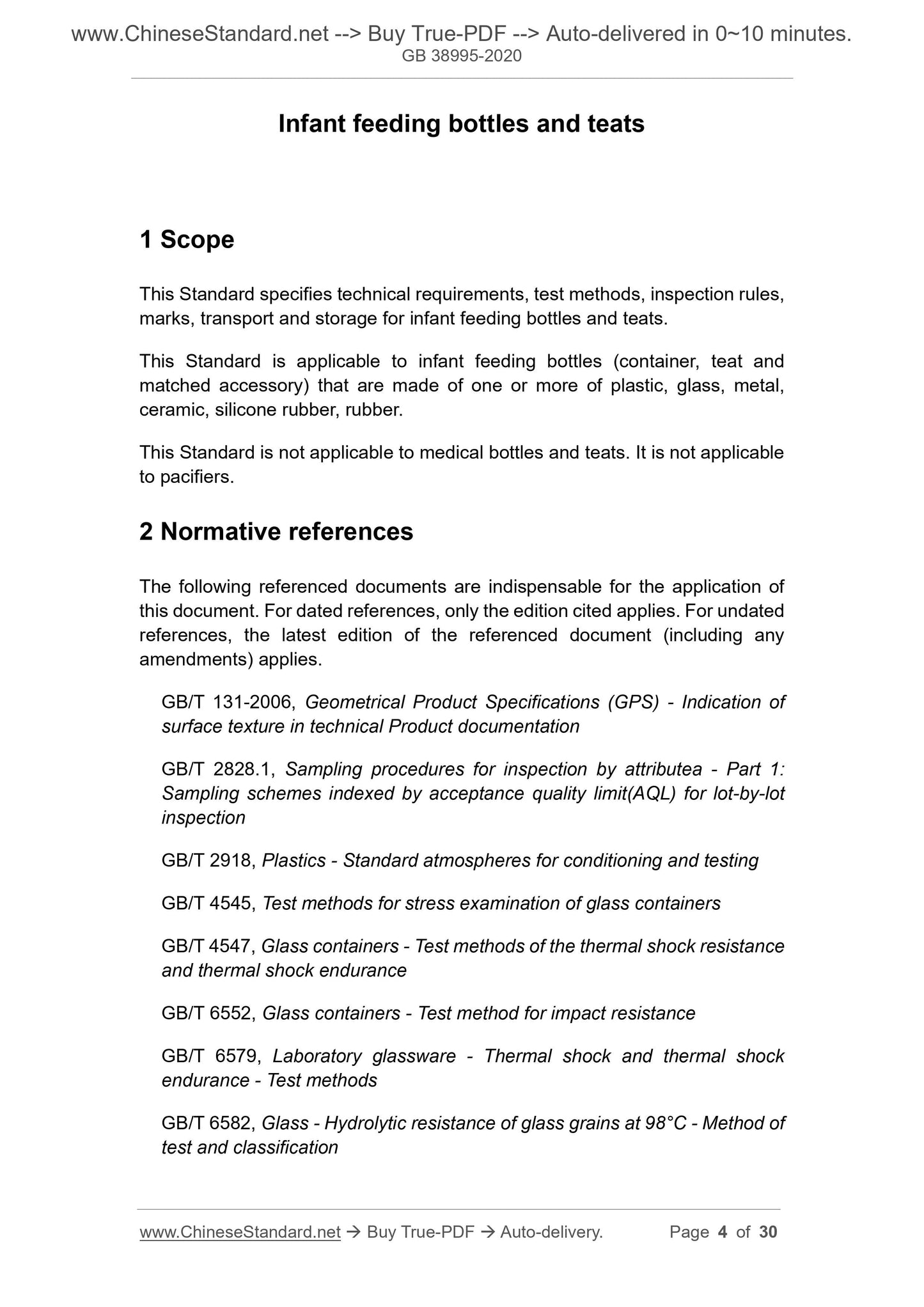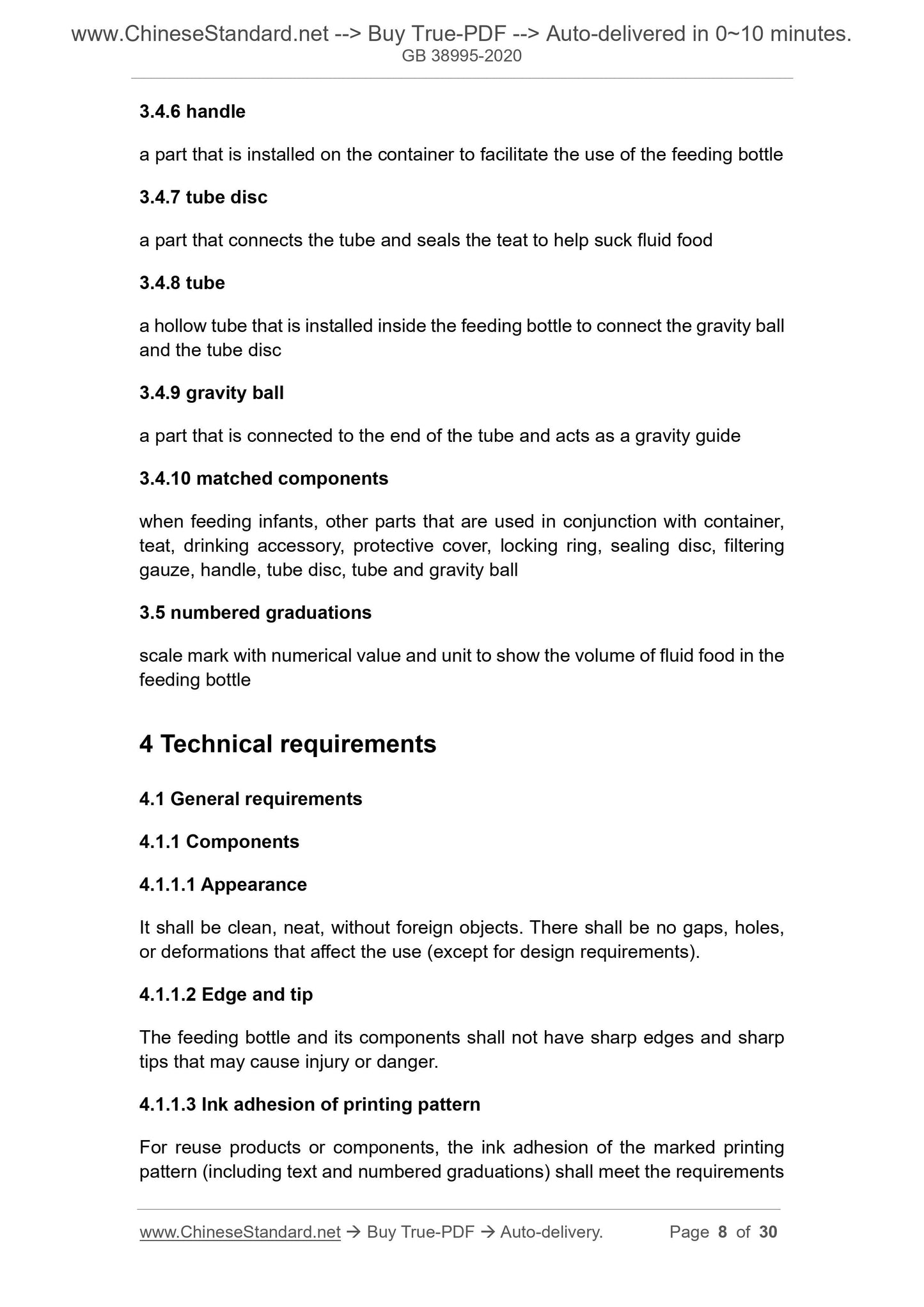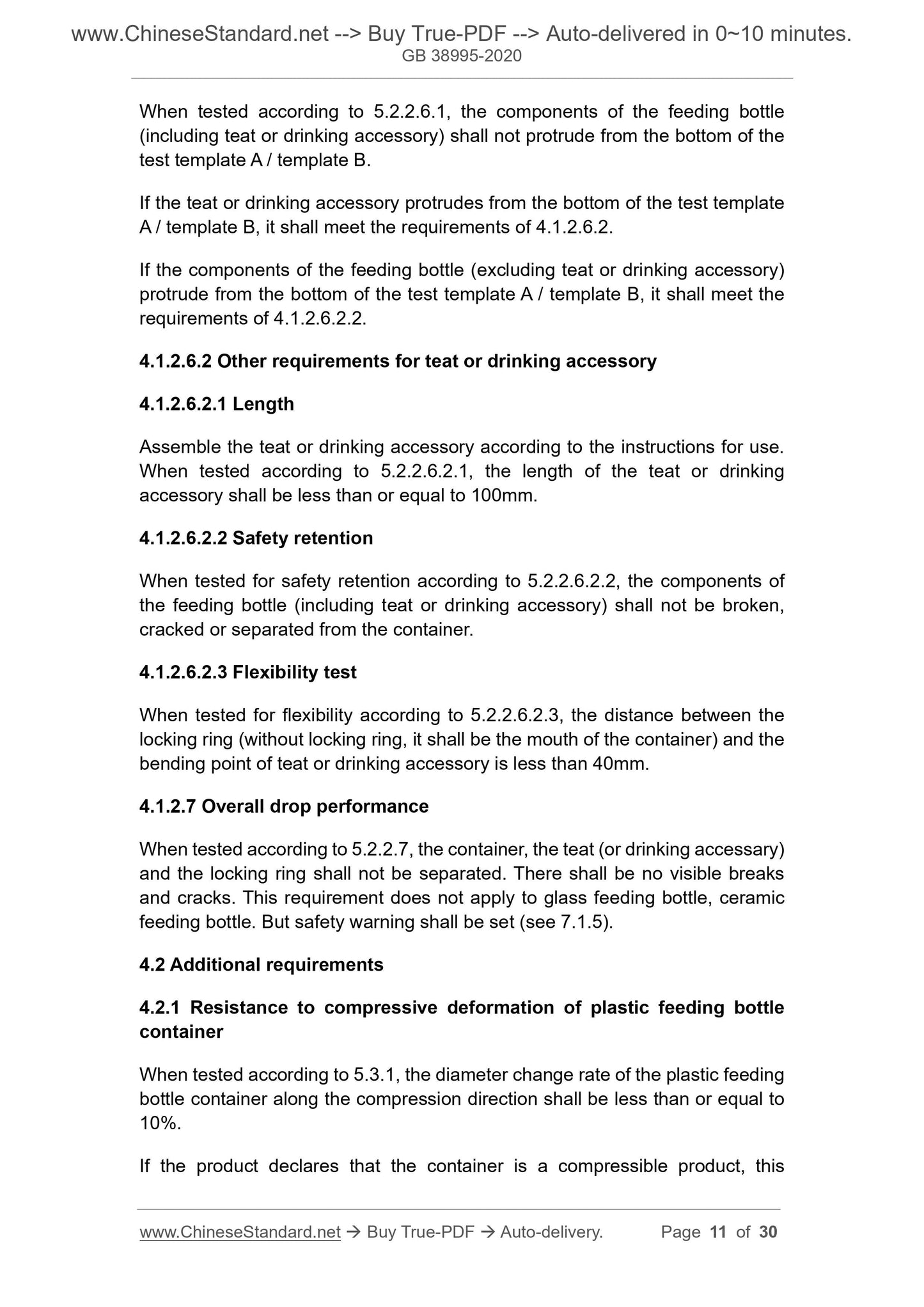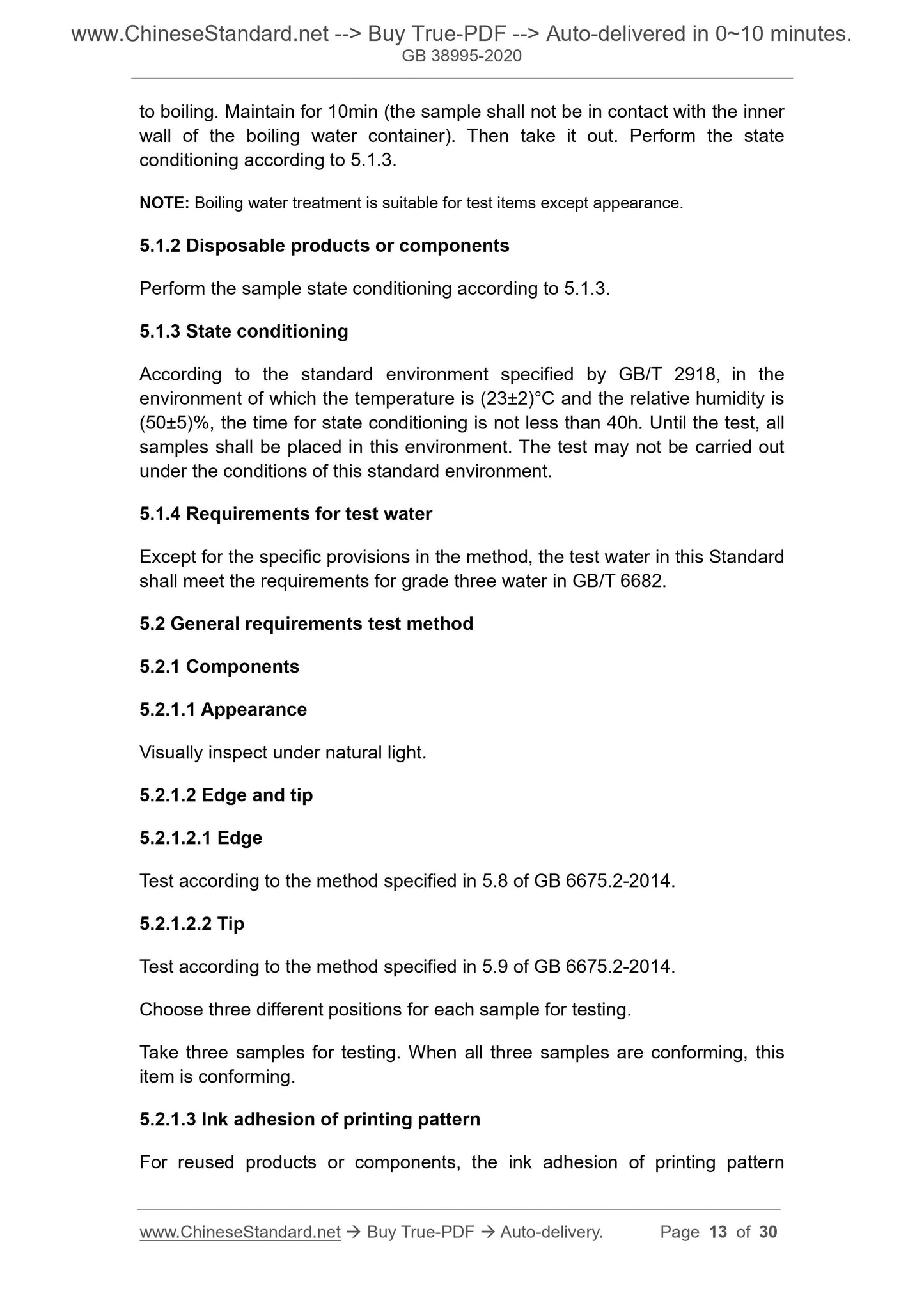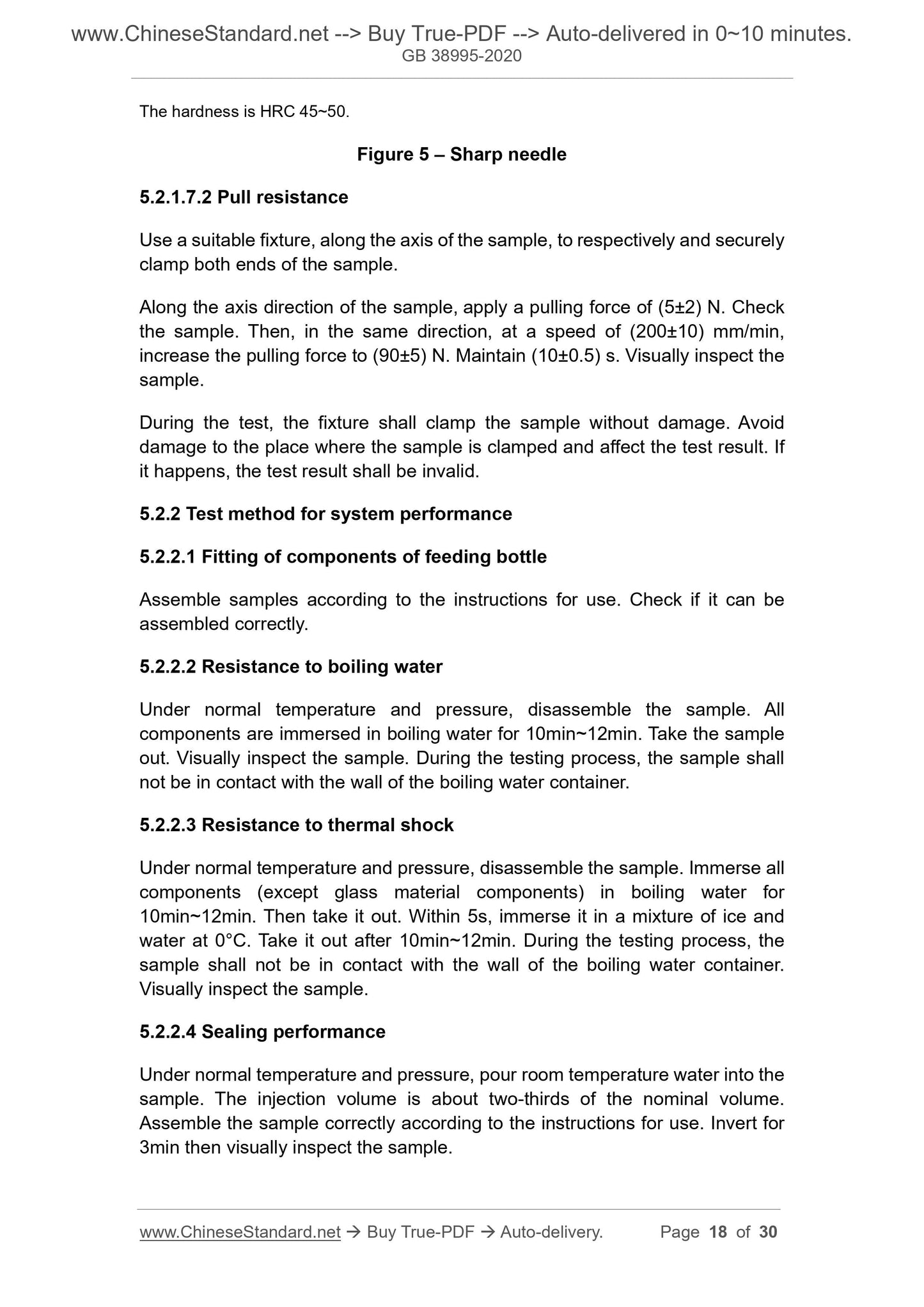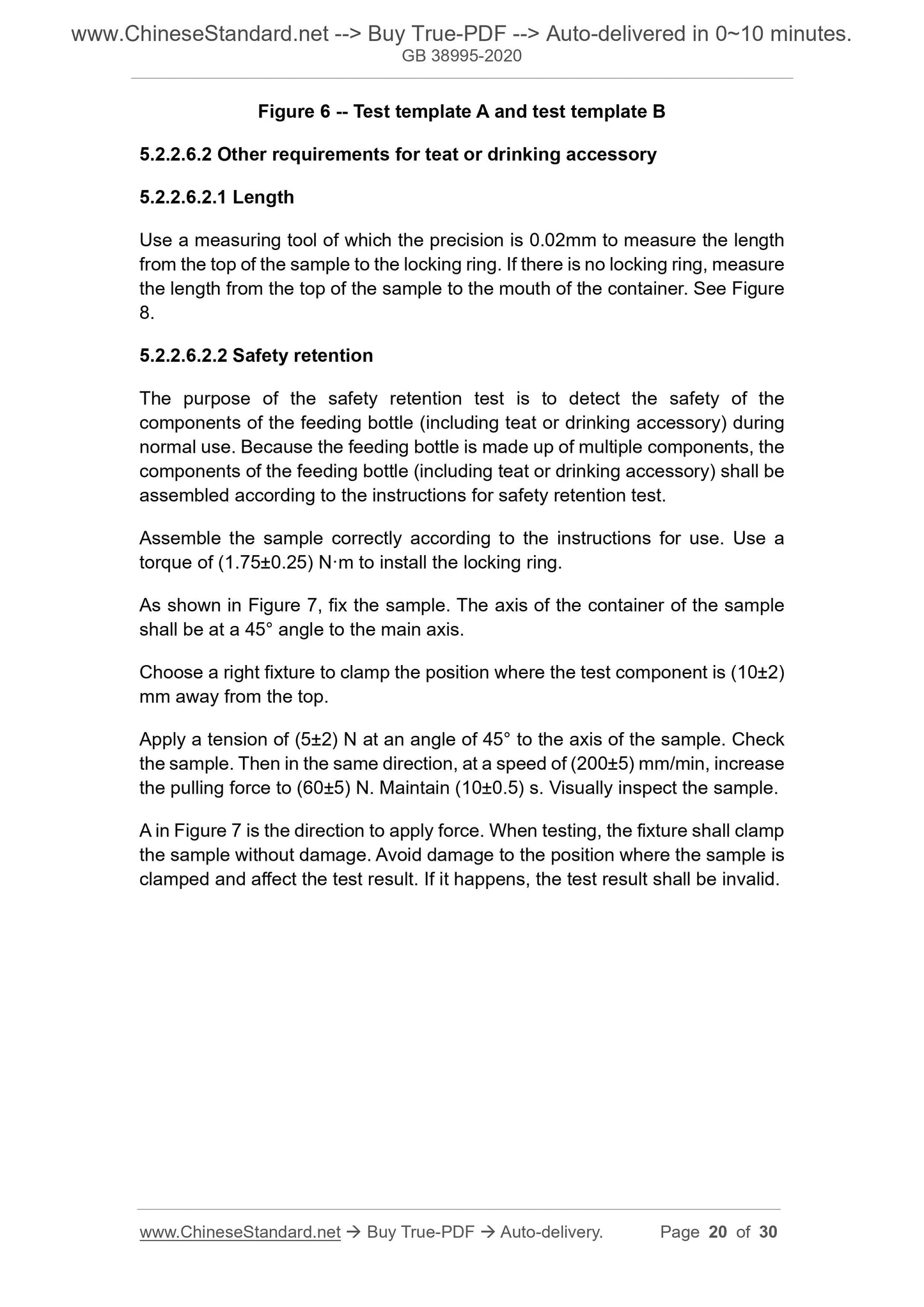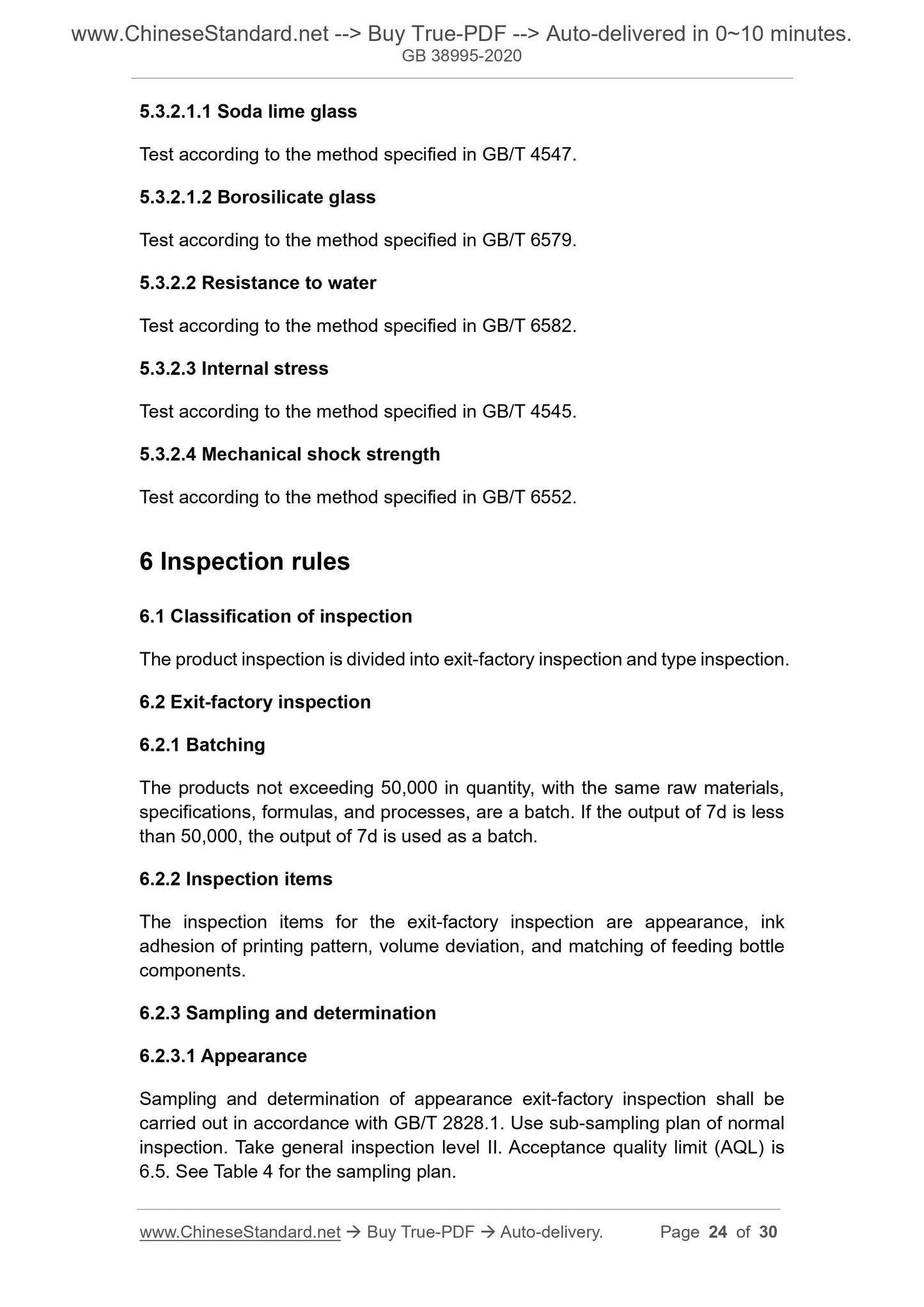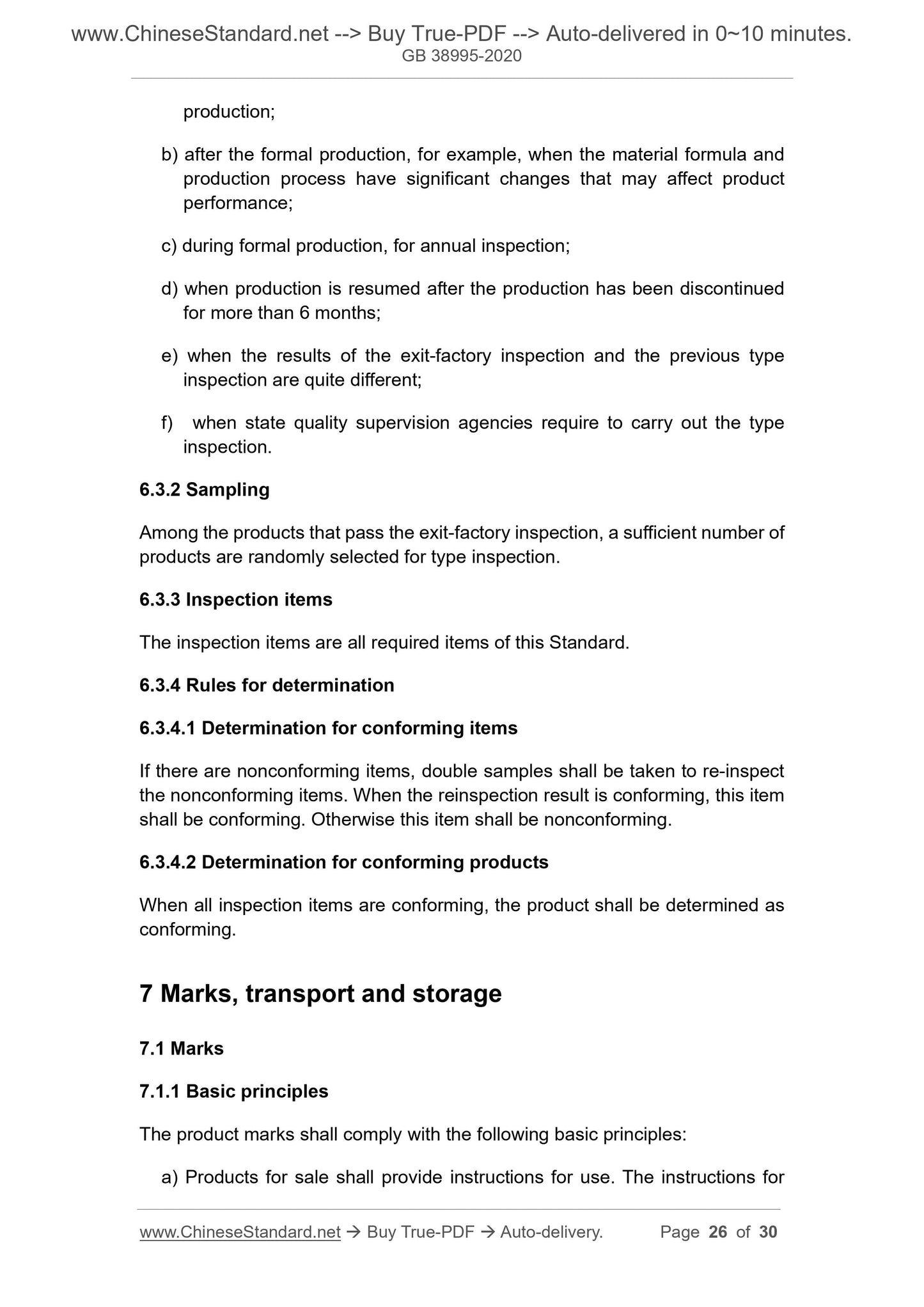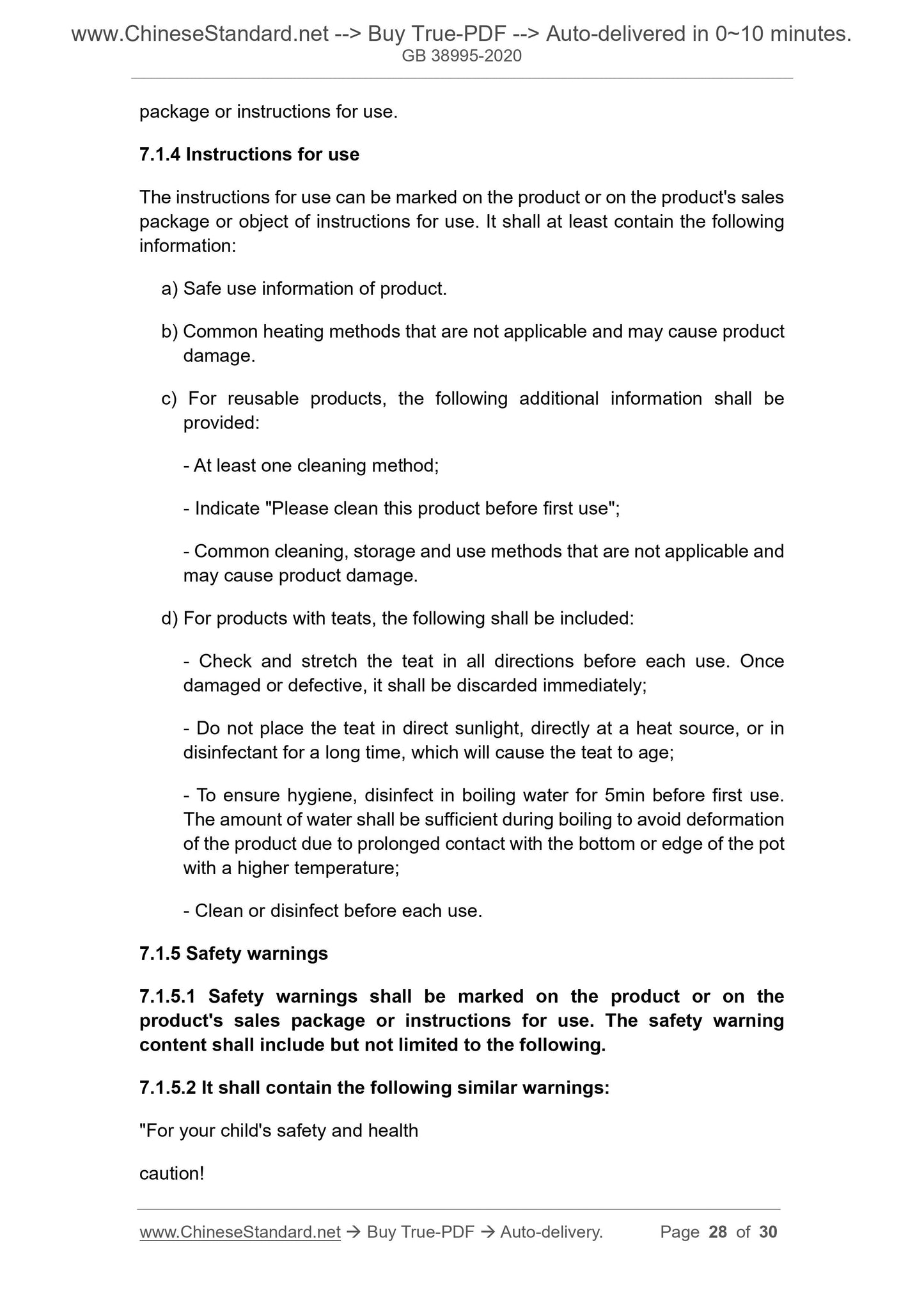1
/
of
11
PayPal, credit cards. Download editable-PDF & invoice in 1 second!
GB 38995-2020 English PDF
GB 38995-2020 English PDF
Regular price
$285.00 USD
Regular price
Sale price
$285.00 USD
Unit price
/
per
Shipping calculated at checkout.
Couldn't load pickup availability
Delivery: 3 seconds. Download true-PDF + Invoice.
Get QUOTATION in 1-minute: Click GB 38995-2020
Historical versions: GB 38995-2020
Preview True-PDF (Reload/Scroll if blank)
GB 38995-2020: Infant feeding bottles and teats
GB 38995-2020
GB
NATIONAL STANDARD OF THE
PEOPLE’S REPUBLIC OF CHINA
ICS 83.140.01
Y 28
Infant feeding bottles and teats
ISSUED ON: OCTOBER 21, 2020
IMPLEMENTED ON: NOVEMBER 01, 2021
Issued by: State Administration for Market Regulation;
Standardization Administration of the People's Republic of
China.
Table of Contents
Foreword ... 3
1 Scope ... 4
2 Normative references ... 4
3 Terms and definitions ... 5
4 Technical requirements ... 8
4.1 General requirements... 8
4.2 Additional requirements ... 11
5 Test methods ... 12
5.1 Sample preparation ... 12
5.2 General requirements test method ... 13
5.3 Test method for additional requirements ... 22
6 Inspection rules ... 24
6.1 Classification of inspection ... 24
6.2 Exit-factory inspection ... 24
6.3 Type inspection ... 25
7 Marks, transport and storage ... 26
7.1 Marks ... 26
7.2 Transport and storage ... 30
Infant feeding bottles and teats
1 Scope
This Standard specifies technical requirements, test methods, inspection rules,
marks, transport and storage for infant feeding bottles and teats.
This Standard is applicable to infant feeding bottles (container, teat and
matched accessory) that are made of one or more of plastic, glass, metal,
ceramic, silicone rubber, rubber.
This Standard is not applicable to medical bottles and teats. It is not applicable
to pacifiers.
2 Normative references
The following referenced documents are indispensable for the application of
this document. For dated references, only the edition cited applies. For undated
references, the latest edition of the referenced document (including any
amendments) applies.
GB/T 131-2006, Geometrical Product Specifications (GPS) - Indication of
surface texture in technical Product documentation
GB/T 2828.1, Sampling procedures for inspection by attributea - Part 1:
Sampling schemes indexed by acceptance quality limit(AQL) for lot-by-lot
inspection
GB/T 2918, Plastics - Standard atmospheres for conditioning and testing
GB/T 4545, Test methods for stress examination of glass containers
GB/T 4547, Glass containers - Test methods of the thermal shock resistance
and thermal shock endurance
GB/T 6552, Glass containers - Test method for impact resistance
GB/T 6579, Laboratory glassware - Thermal shock and thermal shock
endurance - Test methods
GB/T 6582, Glass - Hydrolytic resistance of glass grains at 98°C - Method of
test and classification
3.4.6 handle
a part that is installed on the container to facilitate the use of the feeding bottle
3.4.7 tube disc
a part that connects the tube and seals the teat to help suck fluid food
3.4.8 tube
a hollow tube that is installed inside the feeding bottle to connect the gravity ball
and the tube disc
3.4.9 gravity ball
a part that is connected to the end of the tube and acts as a gravity guide
3.4.10 matched components
when feeding infants, other parts that are used in conjunction with container,
teat, drinking accessory, protective cover, locking ring, sealing disc, filtering
gauze, handle, tube disc, tube and gravity ball
3.5 numbered graduations
scale mark with numerical value and unit to show the volume of fluid food in the
feeding bottle
4 Technical requirements
4.1 General requirements
4.1.1 Components
4.1.1.1 Appearance
It shall be clean, neat, without foreign objects. There shall be no gaps, holes,
or deformations that affect the use (except for design requirements).
4.1.1.2 Edge and tip
The feeding bottle and its components shall not have sharp edges and sharp
tips that may cause injury or danger.
4.1.1.3 Ink adhesion of printing pattern
For reuse products or components, the ink adhesion of the marked printing
pattern (including text and numbered graduations) shall meet the requirements
When tested according to 5.2.2.6.1, the components of the feeding bottle
(including teat or drinking accessory) shall not protrude from the bottom of the
test template A / template B.
If the teat or drinking accessory protrudes from the bottom of the test template
A / template B, it shall meet the requirements of 4.1.2.6.2.
If the components of the feeding bottle (excluding teat or drinking accessory)
protrude from the bottom of the test template A / template B, it shall meet the
requirements of 4.1.2.6.2.2.
4.1.2.6.2 Other requirements for teat or drinking accessory
4.1.2.6.2.1 Length
Assemble the teat or drinking accessory according to the instructions for use.
When tested according to 5.2.2.6.2.1, the length of the teat or drinking
accessory shall be less than or equal to 100mm.
4.1.2.6.2.2 Safety retention
When tested for safety retention according to 5.2.2.6.2.2, the components of
the feeding bottle (including teat or drinking accessory) shall not be broken,
cracked or separated from the container.
4.1.2.6.2.3 Flexibility test
When tested for flexibility according to 5.2.2.6.2.3, the distance between the
locking ring (without locking ring, it shall be the mouth of the container) and the
bending point of teat or drinking accessory is less than 40mm.
4.1.2.7 Overall drop performance
When tested according to 5.2.2.7, the container, the teat (or drinking accessary)
and the locking ring shall not be separated. There shall be no visible breaks
and cracks. This requirement does not apply to glass feeding bottle, ceramic
feeding bottle. But safety warning shall be set (see 7.1.5).
4.2 Additional requirements
4.2.1 Resistance to compressive deformation of plastic feeding bottle
container
When tested according to 5.3.1, the diameter change rate of the plastic feeding
bottle container along the compression direction shall be less than or equal to
10%.
If the product declares that the container is a compressible product, this
to boiling. Maintain for 10min (the sample shall not be in contact with the inner
wall of the boiling water container). Then take it out. Perform the state
conditioning according to 5.1.3.
NOTE: Boiling water treatment is suitable for test items except appearance.
5.1.2 Disposable products or components
Perform the sample state conditioning according to 5.1.3.
5.1.3 State conditioning
According to the standard environment specified by GB/T 2918, in the
environment of which the temperature is (23±2)°C and the relative humidity is
(50±5)%, the time for state conditioning is not less than 40h. Until the test, all
samples shall be placed in this environment. The test may not be carried out
under the conditions of this standard environment.
5.1.4 Requirements for test water
Except for the specific provisions in the method, the test water in this Standard
shall meet the requirements for grade three water in GB/T 6682.
5.2 General requirements test method
5.2.1 Components
5.2.1.1 Appearance
Visually inspect under natural light.
5.2.1.2 Edge and tip
5.2.1.2.1 Edge
Test according to the method specified in 5.8 of GB 6675.2-2014.
5.2.1.2.2 Tip
Test according to the method specified in 5.9 of GB 6675.2-2014.
Choose three different positions for each sample for testing.
Take three samples for testing. When all three samples are conforming, this
item is conforming.
5.2.1.3 Ink adhesion of printing pattern
For reused products or components, the ink adhesion of printing pattern
The hardness is HRC 45~50.
Figure 5 – Sharp needle
5.2.1.7.2 Pull resistance
Get QUOTATION in 1-minute: Click GB 38995-2020
Historical versions: GB 38995-2020
Preview True-PDF (Reload/Scroll if blank)
GB 38995-2020: Infant feeding bottles and teats
GB 38995-2020
GB
NATIONAL STANDARD OF THE
PEOPLE’S REPUBLIC OF CHINA
ICS 83.140.01
Y 28
Infant feeding bottles and teats
ISSUED ON: OCTOBER 21, 2020
IMPLEMENTED ON: NOVEMBER 01, 2021
Issued by: State Administration for Market Regulation;
Standardization Administration of the People's Republic of
China.
Table of Contents
Foreword ... 3
1 Scope ... 4
2 Normative references ... 4
3 Terms and definitions ... 5
4 Technical requirements ... 8
4.1 General requirements... 8
4.2 Additional requirements ... 11
5 Test methods ... 12
5.1 Sample preparation ... 12
5.2 General requirements test method ... 13
5.3 Test method for additional requirements ... 22
6 Inspection rules ... 24
6.1 Classification of inspection ... 24
6.2 Exit-factory inspection ... 24
6.3 Type inspection ... 25
7 Marks, transport and storage ... 26
7.1 Marks ... 26
7.2 Transport and storage ... 30
Infant feeding bottles and teats
1 Scope
This Standard specifies technical requirements, test methods, inspection rules,
marks, transport and storage for infant feeding bottles and teats.
This Standard is applicable to infant feeding bottles (container, teat and
matched accessory) that are made of one or more of plastic, glass, metal,
ceramic, silicone rubber, rubber.
This Standard is not applicable to medical bottles and teats. It is not applicable
to pacifiers.
2 Normative references
The following referenced documents are indispensable for the application of
this document. For dated references, only the edition cited applies. For undated
references, the latest edition of the referenced document (including any
amendments) applies.
GB/T 131-2006, Geometrical Product Specifications (GPS) - Indication of
surface texture in technical Product documentation
GB/T 2828.1, Sampling procedures for inspection by attributea - Part 1:
Sampling schemes indexed by acceptance quality limit(AQL) for lot-by-lot
inspection
GB/T 2918, Plastics - Standard atmospheres for conditioning and testing
GB/T 4545, Test methods for stress examination of glass containers
GB/T 4547, Glass containers - Test methods of the thermal shock resistance
and thermal shock endurance
GB/T 6552, Glass containers - Test method for impact resistance
GB/T 6579, Laboratory glassware - Thermal shock and thermal shock
endurance - Test methods
GB/T 6582, Glass - Hydrolytic resistance of glass grains at 98°C - Method of
test and classification
3.4.6 handle
a part that is installed on the container to facilitate the use of the feeding bottle
3.4.7 tube disc
a part that connects the tube and seals the teat to help suck fluid food
3.4.8 tube
a hollow tube that is installed inside the feeding bottle to connect the gravity ball
and the tube disc
3.4.9 gravity ball
a part that is connected to the end of the tube and acts as a gravity guide
3.4.10 matched components
when feeding infants, other parts that are used in conjunction with container,
teat, drinking accessory, protective cover, locking ring, sealing disc, filtering
gauze, handle, tube disc, tube and gravity ball
3.5 numbered graduations
scale mark with numerical value and unit to show the volume of fluid food in the
feeding bottle
4 Technical requirements
4.1 General requirements
4.1.1 Components
4.1.1.1 Appearance
It shall be clean, neat, without foreign objects. There shall be no gaps, holes,
or deformations that affect the use (except for design requirements).
4.1.1.2 Edge and tip
The feeding bottle and its components shall not have sharp edges and sharp
tips that may cause injury or danger.
4.1.1.3 Ink adhesion of printing pattern
For reuse products or components, the ink adhesion of the marked printing
pattern (including text and numbered graduations) shall meet the requirements
When tested according to 5.2.2.6.1, the components of the feeding bottle
(including teat or drinking accessory) shall not protrude from the bottom of the
test template A / template B.
If the teat or drinking accessory protrudes from the bottom of the test template
A / template B, it shall meet the requirements of 4.1.2.6.2.
If the components of the feeding bottle (excluding teat or drinking accessory)
protrude from the bottom of the test template A / template B, it shall meet the
requirements of 4.1.2.6.2.2.
4.1.2.6.2 Other requirements for teat or drinking accessory
4.1.2.6.2.1 Length
Assemble the teat or drinking accessory according to the instructions for use.
When tested according to 5.2.2.6.2.1, the length of the teat or drinking
accessory shall be less than or equal to 100mm.
4.1.2.6.2.2 Safety retention
When tested for safety retention according to 5.2.2.6.2.2, the components of
the feeding bottle (including teat or drinking accessory) shall not be broken,
cracked or separated from the container.
4.1.2.6.2.3 Flexibility test
When tested for flexibility according to 5.2.2.6.2.3, the distance between the
locking ring (without locking ring, it shall be the mouth of the container) and the
bending point of teat or drinking accessory is less than 40mm.
4.1.2.7 Overall drop performance
When tested according to 5.2.2.7, the container, the teat (or drinking accessary)
and the locking ring shall not be separated. There shall be no visible breaks
and cracks. This requirement does not apply to glass feeding bottle, ceramic
feeding bottle. But safety warning shall be set (see 7.1.5).
4.2 Additional requirements
4.2.1 Resistance to compressive deformation of plastic feeding bottle
container
When tested according to 5.3.1, the diameter change rate of the plastic feeding
bottle container along the compression direction shall be less than or equal to
10%.
If the product declares that the container is a compressible product, this
to boiling. Maintain for 10min (the sample shall not be in contact with the inner
wall of the boiling water container). Then take it out. Perform the state
conditioning according to 5.1.3.
NOTE: Boiling water treatment is suitable for test items except appearance.
5.1.2 Disposable products or components
Perform the sample state conditioning according to 5.1.3.
5.1.3 State conditioning
According to the standard environment specified by GB/T 2918, in the
environment of which the temperature is (23±2)°C and the relative humidity is
(50±5)%, the time for state conditioning is not less than 40h. Until the test, all
samples shall be placed in this environment. The test may not be carried out
under the conditions of this standard environment.
5.1.4 Requirements for test water
Except for the specific provisions in the method, the test water in this Standard
shall meet the requirements for grade three water in GB/T 6682.
5.2 General requirements test method
5.2.1 Components
5.2.1.1 Appearance
Visually inspect under natural light.
5.2.1.2 Edge and tip
5.2.1.2.1 Edge
Test according to the method specified in 5.8 of GB 6675.2-2014.
5.2.1.2.2 Tip
Test according to the method specified in 5.9 of GB 6675.2-2014.
Choose three different positions for each sample for testing.
Take three samples for testing. When all three samples are conforming, this
item is conforming.
5.2.1.3 Ink adhesion of printing pattern
For reused products or components, the ink adhesion of printing pattern
The hardness is HRC 45~50.
Figure 5 – Sharp needle
5.2.1.7.2 Pull resistance
Share
